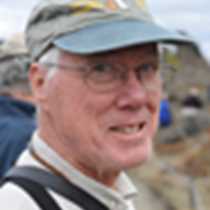The San Juan Islands, Washington
We spent our first night aboardSea Bird gently rocking at anchor in Eagle Harbor, on the east side of Cypress Island in the San Juan group. The San Juans are a hidden jewel of the Pacific Northwest. The mountains of the Olympic Peninsula intercept moist westerly winds from the Pacific Ocean, making that one of the wettest spots in North America. The San Juan Islands are in the rain shadow of the Olympic Peninsula. A soft morning drizzle soon gave way to dry, if overcast, conditions. We enjoyed Cypress Island in two ways: by foot and by Zodiac. Walkers donned their rubber boots for the ubiquitous Lindblad Expeditions wet landing and stepped ashore into a small coastal meadow. A long-abandoned road provided easy access for our first exposure to the Temperate Rain Forest of the Pacific Northwest. The characteristic features of this ecosystem were clear to see: the dominance of coniferous trees, and a multi-layered canopy with an abundance of mosses and ferns growing on the ground and on the trunks and larger branches of forest trees. Along the road edge, where light can penetrate, we found shrubs in early spring flowering: the white sprays of Pacific elderberry, bright orange trumpet honeysuckle, and deep magenta salmonberry. Salmonberry is the first of our shrubs to flower in spring, and the ripe fruit are anxiously awaited by people living in the rainforest. We also found some of the characteristic denizens of the forest: a small garter snake, Pacific tree frog, and the noble banana slug. Zodiac tours provided another view of the forest and the surrounding intertidal communities. We saw quite a few bald eagles roosting near the tops of tall trees, waiting for the summer influx of salmon upon which they will soon gorge and raise the next generation.
We continued on, northward, and passed into Canadian waters. The foredeck of Sea Bird provides a perfect spot to enjoy the surrounding scenery and practice our developing skills at identifying seabirds: rhinoceros auklets, pigeon guillemots, pelagic cormorants, a passing Pacific loon in its elegant breeding plumage, and more. After a stop at Sydney, British Columbia to officially enter Canada, we continued onward through Active Pass, where tidal currents rush through a gap between the islands, on our way up the Inside Passage between Vancouver Island and the mainland of British Columbia.
We spent our first night aboardSea Bird gently rocking at anchor in Eagle Harbor, on the east side of Cypress Island in the San Juan group. The San Juans are a hidden jewel of the Pacific Northwest. The mountains of the Olympic Peninsula intercept moist westerly winds from the Pacific Ocean, making that one of the wettest spots in North America. The San Juan Islands are in the rain shadow of the Olympic Peninsula. A soft morning drizzle soon gave way to dry, if overcast, conditions. We enjoyed Cypress Island in two ways: by foot and by Zodiac. Walkers donned their rubber boots for the ubiquitous Lindblad Expeditions wet landing and stepped ashore into a small coastal meadow. A long-abandoned road provided easy access for our first exposure to the Temperate Rain Forest of the Pacific Northwest. The characteristic features of this ecosystem were clear to see: the dominance of coniferous trees, and a multi-layered canopy with an abundance of mosses and ferns growing on the ground and on the trunks and larger branches of forest trees. Along the road edge, where light can penetrate, we found shrubs in early spring flowering: the white sprays of Pacific elderberry, bright orange trumpet honeysuckle, and deep magenta salmonberry. Salmonberry is the first of our shrubs to flower in spring, and the ripe fruit are anxiously awaited by people living in the rainforest. We also found some of the characteristic denizens of the forest: a small garter snake, Pacific tree frog, and the noble banana slug. Zodiac tours provided another view of the forest and the surrounding intertidal communities. We saw quite a few bald eagles roosting near the tops of tall trees, waiting for the summer influx of salmon upon which they will soon gorge and raise the next generation.
We continued on, northward, and passed into Canadian waters. The foredeck of Sea Bird provides a perfect spot to enjoy the surrounding scenery and practice our developing skills at identifying seabirds: rhinoceros auklets, pigeon guillemots, pelagic cormorants, a passing Pacific loon in its elegant breeding plumage, and more. After a stop at Sydney, British Columbia to officially enter Canada, we continued onward through Active Pass, where tidal currents rush through a gap between the islands, on our way up the Inside Passage between Vancouver Island and the mainland of British Columbia.




